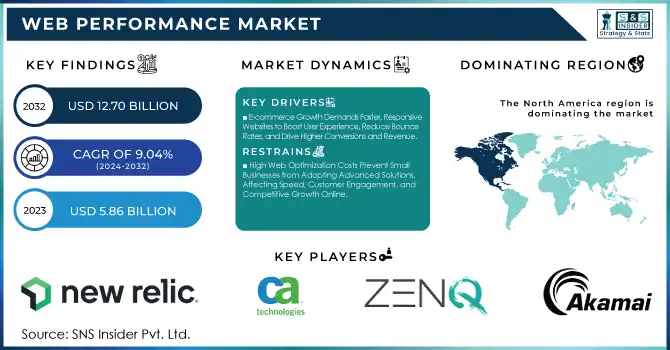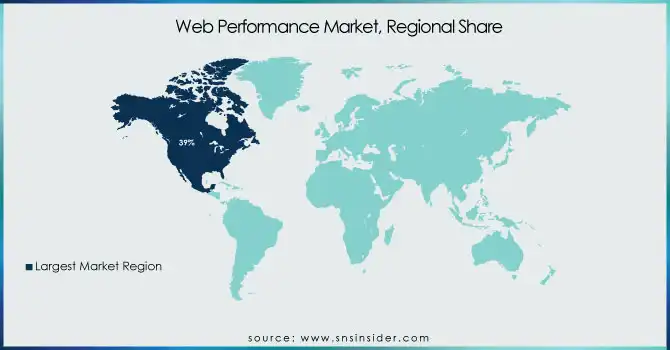Web Performance Market Report Scope & Overview:
The Web Performance Market was valued at USD 5.86 billion in 2023 and is projected to reach USD 12.70 billion by 2032, growing at a CAGR of 9.04% from 2024 to 2032. This report includes an analysis of performance metrics, investment trends, customer satisfaction scores, cybersecurity impact, and traffic & usage data. The market is driven by increasing demand for faster, more reliable digital experiences, rising cybersecurity concerns, and growing adoption of cloud-based solutions. Investments in AI-driven optimization and edge computing are enhancing web performance capabilities, while user satisfaction remains a key factor influencing competitive strategies across industries.

To get more information on Web Performance Market - Request Free Sample Report
Web Performance Market Dynamics
Drivers
-
E-commerce Growth Demands Faster, Responsive Websites to Boost User Experience, Reduce Bounce Rates, and Drive Higher Conversions and Revenue.
The rapid expansion of e-commerce has accelerated the demand for websites that provide seamless, speedy, and responsive experiences. Instant page loading, seamless navigation, and uninterrupted transactions are what customers expect, so performance optimization becomes a top priority for companies. Poorly optimized or slow websites result in increased bounce rates, cart abandonment, and lost business opportunities. Further, with mobile shopping on the rise, responsiveness across devices is critical to maintaining customer loyalty. With growing competition, companies need to spend on web performance solutions to sustain user interest and facilitate conversions. Faster website loading and uptime enhance customer satisfaction while also leading to better search engine rankings, reinforcing the brand online and in long-term growth.
Restraints
-
High Web Optimization Costs Prevent Small Businesses from Adopting Advanced Solutions, Affecting Speed, Customer Engagement, and Competitive Growth Online.
Installing sophisticated web performance solutions involves huge amounts of money to be spent on tools, infrastructure, and maintenance. Most small and medium enterprises cannot find room to spend the required money on premium performance optimization technologies such as content delivery networks (CDNs), load balancing, and real-time monitoring systems. The money spent on recruiting experienced professionals to maintain and optimize web performance also makes it a costly affair. As bigger companies achieve a competitive advantage by using premium solutions, small companies struggle to provide speed, responsiveness, and uptime. In the lack of proper resources, they end up sacrificing website performance at slower rates, elevated bounce rates, and lower customer interactions, eventually impacting their capability to compete in the digital market.
Opportunities
-
AI and Automation Enhance Web Performance by Optimizing Speed, Reducing Manual Effort, Predicting Issues, and Ensuring Seamless User Experience.
The integration of automation and artificial intelligence is transforming web performance by facilitating quicker, more effective optimization. AI-based solutions scan live user behavior, anticipate performance issues, and apply proactive fixes automatically without the need for human intervention. Automated monitoring of performance and load balancing guarantee that websites operate at their best speed, responsiveness, and uptime, even in the event of traffic surges. These smart systems decrease the reliance on IT staff, enabling organizations to use their resources more efficiently. With more complicated digital experiences, AI-based solutions optimize content delivery, increase page loading times, and deliver improved user satisfaction. The rise of AI and automation offers companies a cost-effective method to keep the web experience smooth and stay competitive in the new digital age.
Challenges
-
Balancing Website Security and Speed is Critical as Firewalls, Encryption, and Compliance Measures Can Impact Performance and User Experience.
With the growth of cyber threats, companies need to have strong security controls like firewalls, encryption, and DDoS protection to secure their websites. But these security controls add latency, which affects website loading times and responsiveness. Balancing security and performance is a difficult challenge because too many security layers can be costly in terms of page loading speed, making users impatient and bouncing more. Also, security patches and compliance updates require constant surveillance and adjustments, which also adds to the difficulties of optimizing the website. Companies need to embrace progressive solutions that blend security in an unobtrusive manner without compromising on speed, providing a secure but high-quality digital experience for users along with customer trust and interest.
Web Performance Market Segment Analysis
By Component
The Solution segment led the Web Performance Market with a 69% revenue share in 2023 owing to the rising usage of performance optimization tools, content delivery networks, and automation through AI. Companies focus on solutions that accelerate website speed, provide low latency, and improve user experience, which results in large-scale deployment. Moreover, increasing dependence on cloud-based platforms and real-time monitoring solutions has also increased the demand for web performance solutions.
The Services segment will expand at the fastest CAGR of 11.25% during the forecast period 2024-2032 due to increasing demand for consulting, implementation, and managed services. As companies aim to optimize web performance, expert advice is needed to implement solutions properly. Increasing complexity in website architectures and the requirement for ongoing monitoring, security management, and performance optimization drive service-based offerings at a fast pace.
By Deployment
The Cloud segment led the Web Performance Market with a 58% revenue share in 2023 because cloud-based optimization solutions have been widely adopted. Companies like to use cloud platforms because they are scalable, economical, and can provide smooth performance at global locations. Cloud solutions provide real-time monitoring, automated updates, and AI-based analytics, which allow organizations to improve website speed, security, and reliability without making heavy infrastructure investments.
The On-premise segment will grow at the fastest CAGR of 10.47% during the period 2024-2032, led by growing data security and compliance concerns. Organizations dealing with sensitive data prefer on-premise solutions for complete control of web performance infrastructure. Moreover, sectors with stringent compliance needs like finance and healthcare are investing in on-premise deployments to maintain data privacy and optimize website performance and reliability.
By Enterprise Size
The Large Enterprises segment led the Web Performance Market with a 59% revenue share in 2023 because they heavily invested in sophisticated optimization solutions. Large businesses focus on smooth digital experiences, using AI-powered analytics, content delivery networks, and cloud-based performance tools. With high website traffic volumes and international operations, large businesses need strong web performance solutions to guarantee speed, security, and uptime, improving user engagement and competitive positioning.
The Small & Medium Enterprises segment is projected to grow at the fastest CAGR of 10.01% during the period 2024-2032, spurred by the surging use of digital platforms and cloud-based performance solutions. As SMEs move their presence online, they are looking for low-cost optimization solutions to improve website speed and user experience. Increasing affordability of web performance services and the surging demand for competitive differentiation also boost market growth in this segment.
By End Use
The Retail & E-commerce market led the Web Performance Market with a 29% share in revenue during 2023 based on the sheer necessity for rapid, lag-free, and interactive websites. Performance optimization is at the top of the priority list for e-tailers in order to decrease bounce rates, improve the user experience, and boost conversions. The surge in mobile shopping, online payments, and individualized recommendations additionally boosts the web performance solution requirement for this vertical.
The IT & Telecom segment is likely to witness the fastest CAGR of 11.29% during the forecast period from 2024 to 2032, owing to the high-growth development of digital infrastructure and cloud computing. With companies transitioning to cloud apps and remote working paradigms, IT and telecom vendors need high-performance web solutions to provide low latency and uptime. The expansion of 5G and edge computing also builds demand for enhanced web performance technologies.
Regional Analysis
North America led the Web Performance Market with 39% revenue market share in 2023 owing to the large presence of leading technology firms and cloud companies. High penetration of internet, early adoption of sophisticated web optimization technologies, and growing e-commerce further lead to market leadership. Companies in the region are eager to implement digital transformation, AI-based analytics, and cybersecurity, thus demanding web performance solutions. Moreover, strict regulations regarding data security and user experience further fuel the uptake of performance-improving technologies.
The Asia Pacific region is expected to grow at the fastest CAGR of 10.59% during 2024-2032, fueled by speedy digitalization, growing internet users, and a thriving e-commerce sector. China, India, and Japan are seeing huge investments in cloud computing and mobile networks, boosting the demand for web performance solutions. The emergence of 5G, increasing smartphone penetration, and enlarging startup hubs further intensify the demand for quicker, more responsive online experiences throughout the region.

Get Customized Report as per Your Business Requirement - Enquiry Now
Key Players
-
Akamai (Ion, Kona Site Defender)
-
ZenQ (Web Performance Testing Services, Mobile Performance Testing Services)
-
CA Technologies (Application Performance Management, App Synthetic Monitor)
-
New Relic (New Relic APM, New Relic Browser)
-
ThousandEyes (Cloud Performance Monitoring, Internet Insights)
-
Cavisson (NetStorm, NetDiagnostics)
-
F5 Networks (BIG-IP Local Traffic Manager, BIG-IP Application Security Manager)
-
Neustar (UltraDNS, Website Performance Monitoring)
-
CDNetworks (Content Acceleration, Cloud Security)
-
Netmagic (Cloud CDN Services, Application Performance Monitoring)
-
Micro Focus (LoadRunner, AppPulse)
-
Cloudflare (Content Delivery Network, Argo Smart Routing)
-
Dynatrace (Digital Experience Monitoring, Application Performance Monitoring)
-
IBM (IBM Application Performance Management, IBM Content Delivery Network)
-
Radware Ltd. (FastView, AppWall)
-
Fastly (Content Delivery Network, Image Optimization)
-
SolarWinds (Pingdom, Web Performance Monitor)
-
Amazon Web Services (AWS) (CloudFront, AWS Global Accelerator)
-
Google Cloud (Cloud CDN, Cloud Load Balancing)
-
Microsoft Azure (Azure Front Door, Azure CDN)
-
Alibaba Cloud (Alibaba Cloud CDN, Alibaba Cloud WAF)
-
StackPath (StackPath CDN, StackPath WAF)
-
KeyCDN (HTTP/2 CDN, Image Processing)
-
Imperva (Incapsula CDN, Incapsula WAF)
-
Sucuri (Website Firewall, Content Delivery Network)
Recent Developments:
-
In November 2024, Akamai Technologies extended its microsegmentation solution, Akamai Guardicore Segmentation, to support agentless enforcement for cloud-native resources in Amazon Web Services (AWS).
-
In October 2021, Wipro partnered with Micro Focus to launch a Legacy Migration and Modernisation Lab in Sydney, Australia, collaborating with Amazon Web Services (AWS) to help businesses in Australia and New Zealand transition legacy applications to the cloud
| Report Attributes | Details |
|---|---|
| Market Size in 2023 | USD 5.86 Billion |
| Market Size by 2032 | USD 12.70 Billion |
| CAGR | CAGR of 9.04% From 2024 to 2032 |
| Base Year | 2023 |
| Forecast Period | 2024-2032 |
| Historical Data | 2020-2022 |
| Report Scope & Coverage | Market Size, Segments Analysis, Competitive Landscape, Regional Analysis, DROC & SWOT Analysis, Forecast Outlook |
| Key Segments | • By Component (Solution, Services) • By Deployment (Cloud, On-premise) • By Enterprise Size (Small & Medium Enterprises (SMEs), Large Enterprises) • By End Use (BFSI, IT & Telecom, Manufacturing, Government, Retail & E-commerce, Automotive, Healthcare, Others) |
| Regional Analysis/Coverage | North America (US, Canada, Mexico), Europe (Eastern Europe [Poland, Romania, Hungary, Turkey, Rest of Eastern Europe] Western Europe] Germany, France, UK, Italy, Spain, Netherlands, Switzerland, Austria, Rest of Western Europe]), Asia Pacific (China, India, Japan, South Korea, Vietnam, Singapore, Australia, Rest of Asia Pacific), Middle East & Africa (Middle East [UAE, Egypt, Saudi Arabia, Qatar, Rest of Middle East], Africa [Nigeria, South Africa, Rest of Africa], Latin America (Brazil, Argentina, Colombia, Rest of Latin America) |
| Company Profiles | Akamai, ZenQ, CA Technologies, New Relic, ThousandEyes, Cavisson, F5 Networks, Neustar, CDNetworks, Netmagic, Micro Focus, Cloudflare, Dynatrace, IBM, Radware Ltd., Fastly, SolarWinds, Amazon Web Services (AWS), Google Cloud, Microsoft Azure, Alibaba Cloud, StackPath, KeyCDN, Imperva, Sucuri |

